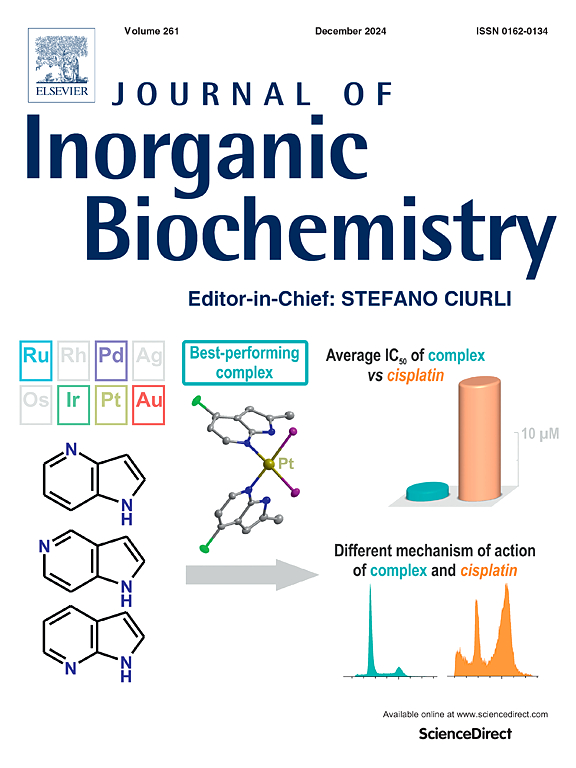Interactions of Li+ ions with NCS1: A potential mechanism of Li+ neuroprotective action against psychotic disorders
IF 3.8
2区 化学
Q2 BIOCHEMISTRY & MOLECULAR BIOLOGY
引用次数: 0
Abstract
Li+ based drugs have been used for the treatment of psychiatric disorders due to their mood stabilizing role for decades. Recently, several studies reported the protective effect of Li+ against severe neuropathologies such as Parkinson's, Alzheimer's, and Huntington's disease. Surprisingly, despite a broad range of Li+ effects on neurological conditions, little is known about its molecular mechanism. In this study, we propose that neuronal calcium sensor 1 (NCS1), can be an effective molecular target for Li+ action. Here we show that the EF-hands in ApoNCS1 have submillimolar affinity for Li+ with Kd = 223 ± 19 μM. Li+ binding to ApoNCS1 quenches Trp emission intensity, suggesting distinct Trp sidechains environment in Li+NCS1 compared to ApoNCS1 and Ca2+NCS1. Li+ association also stabilizes the protein α-helical structure, in a similar way to Ca2+. Li+ association does not promote NCS1 dimerization. Association of Li+ increases NCS1 affinity for the D2R receptor binding peptide, in a similar way to Ca2+, however, the affinity of NCS1 for chlorpromazine is reduced with respect to Ca2+NCS1, possibly due to a decrease in solvent exposed hydrophobic area on the NCS1 surface in the presence of Li+. MD simulation data suggests that Li+ ions are coordinated by four oxygens from Asp and Glu sidechains and one carbonyl oxygen, in a similar way as reported previously for Li+ binding to DREAM. Overall, the data shows that Li+ binds to EF-hands of NCS1 and Li+NCS1 interactions may be involved in the potential neuroprotective role of Li+ against psychotic disorders.

Li+ 离子与 NCS1 的相互作用:Li+ 对精神病神经保护作用的潜在机制。
几十年来,基于 Li+ 的药物因其稳定情绪的作用而被用于治疗精神疾病。最近,一些研究报告了 Li+ 对帕金森氏症、阿尔茨海默氏症和亨廷顿氏症等严重神经病变的保护作用。令人惊讶的是,尽管 Li+ 对神经系统疾病有广泛的影响,但人们对其分子机制却知之甚少。在本研究中,我们提出神经元钙传感器 1(NCS1)可以成为 Li+ 作用的有效分子靶点。在这里,我们发现 ApoNCS1 中的 EF-手对 Li+ 具有亚摩尔亲和力,Kd = 223 ± 19 μM。Li+ 与 ApoNCS1 结合会淬灭 Trp 发射强度,这表明 Li+NCS1 与 ApoNCS1 和 Ca2+NCS1 相比具有不同的 Trp 侧链环境。与 Ca2+ 类似,Li+ 也能稳定蛋白质的 α-helical 结构。Li+ 的结合不会促进 NCS1 的二聚化。与 Ca2+ 类似,Li+ 的结合增加了 NCS1 与 D2R 受体结合肽的亲和力,然而,与 Ca2+NCS1 相比,NCS1 与氯丙嗪的亲和力降低了,这可能是由于 Li+ 存在时 NCS1 表面暴露于溶剂的疏水面积减少了。MD 模拟数据表明,Li+ 离子由来自 Asp 和 Glu 侧链的四个氧原子和一个羰基氧原子配位,与之前报道的 Li+ 与 DREAM 结合的方式类似。总之,这些数据表明 Li+ 与 NCS1 的 EF-手结合,Li+NCS1 的相互作用可能参与了 Li+ 对精神病的潜在神经保护作用。
本文章由计算机程序翻译,如有差异,请以英文原文为准。
求助全文
约1分钟内获得全文
求助全文
来源期刊

Journal of Inorganic Biochemistry
生物-生化与分子生物学
CiteScore
7.00
自引率
10.30%
发文量
336
审稿时长
41 days
期刊介绍:
The Journal of Inorganic Biochemistry is an established international forum for research in all aspects of Biological Inorganic Chemistry. Original papers of a high scientific level are published in the form of Articles (full length papers), Short Communications, Focused Reviews and Bioinorganic Methods. Topics include: the chemistry, structure and function of metalloenzymes; the interaction of inorganic ions and molecules with proteins and nucleic acids; the synthesis and properties of coordination complexes of biological interest including both structural and functional model systems; the function of metal- containing systems in the regulation of gene expression; the role of metals in medicine; the application of spectroscopic methods to determine the structure of metallobiomolecules; the preparation and characterization of metal-based biomaterials; and related systems. The emphasis of the Journal is on the structure and mechanism of action of metallobiomolecules.
 求助内容:
求助内容: 应助结果提醒方式:
应助结果提醒方式:


